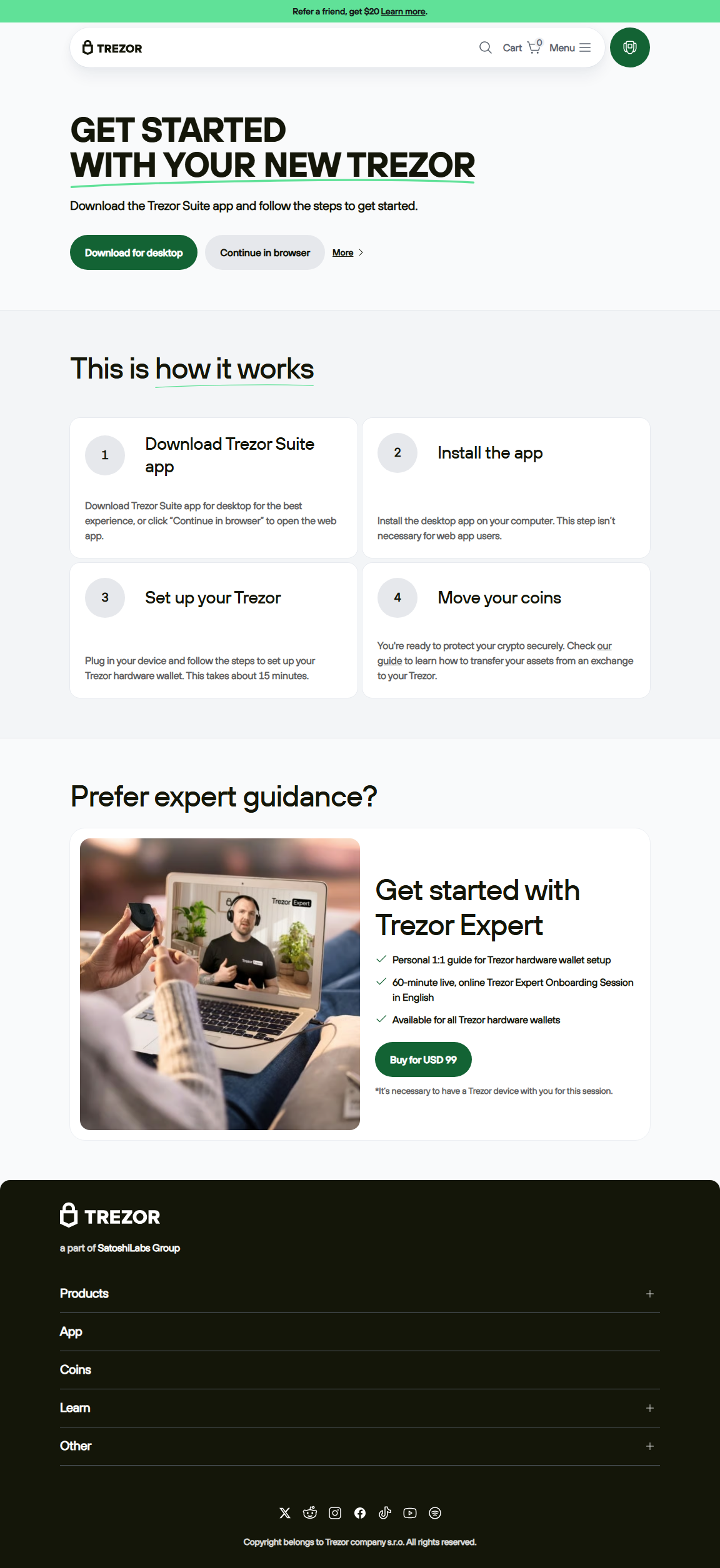Trezor.io/Start — The Ultimate Guide to Setting Up and Securing Your Trezor Wallet
A comprehensive, human-written guide to understanding, setting up, and mastering your Trezor hardware wallet for safe cryptocurrency storage.
🚀 Quick Start Overview
If you've landed on Trezor.io/start, you're likely taking your first step into the world of self-custody — where you become your own bank. This page serves as the official entry point to initialize your Trezor hardware wallet, download the necessary software, and begin managing your crypto assets securely.
🔐 What Is Trezor and Why Does It Matter?
Trezor is a hardware wallet designed to keep your cryptocurrencies safe by storing your private keys offline. Created by SatoshiLabs in 2014, it was the world’s first hardware wallet, setting the gold standard for crypto security. Unlike software wallets, which are vulnerable to malware or phishing, Trezor ensures that your private keys never leave the device.
Think of Trezor as your personal digital vault — even if your computer gets hacked, your crypto remains untouched. For those entering the decentralized finance (DeFi) space, this device is a vital tool in protecting digital wealth.
🧭 Step-by-Step Setup Guide (Trezor.io/Start)
Step 1: Visit Trezor.io/Start
Always type the URL manually or use the link from the product box. Avoid clicking random links from emails or ads — phishing scams mimic official pages.
Step 2: Download Trezor Suite
Trezor Suite is the official desktop app used to manage your device. It’s available for Windows, macOS, and Linux. Once installed, it automatically detects your Trezor device.
Step 3: Connect Your Device
Plug your Trezor Model One or Model T into your computer via USB. Follow on-screen prompts to install firmware and initialize your wallet.
Step 4: Create a New Wallet
The device will display a recovery seed (12–24 words). Write it down carefully — never take a photo or store it digitally. This seed is your master key.
Step 5: Add Accounts and Receive Funds
Once your wallet is initialized, add accounts for Bitcoin, Ethereum, or other supported assets. You can now receive funds by sharing your public address.
⚖️ Trezor vs. Other Hardware Wallets
| Feature | Trezor Model T | Ledger Nano X | SafePal S1 |
|---|---|---|---|
| Open Source | ✅ 100% Open Source | ❌ Closed Firmware | ❌ Partially Closed |
| Touchscreen | ✅ Yes | ❌ No | ✅ Yes |
| Security Chips | Standard MCU (Auditable) | Secure Element | Secure Element |
| Price Range | $$$ (Premium) | $$ (Mid-tier) | $ (Budget) |
Trezor stands out for transparency and open-source code, which appeals to developers and privacy advocates who prefer verifiable security.
🛡️ Advanced Security Tips
- Use a Passphrase: An optional passphrase adds a second layer of protection on top of your recovery seed, effectively creating a hidden wallet.
- Keep Firmware Updated: Updates fix potential vulnerabilities and introduce new features. Always download updates from the official Trezor Suite.
- Verify Addresses on Device: Always confirm receiving addresses on the Trezor screen before sending funds.
- Backup Your Recovery Seed Offline: Store it in a fireproof or metal backup device. Never share it with anyone.
“Not your keys, not your coins.” — The mantra of true crypto ownership.
Using Trezor through Trezor.io/start ensures that you remain in control of your assets — no exchange, no third party, just you and your hardware wallet.
💡 Common Mistakes Beginners Make
- Using Fake Websites: Always verify the domain trezor.io. Scammers create similar-looking URLs to steal seeds.
- Photographing the Seed Phrase: Taking digital backups exposes you to online risks. Keep everything offline.
- Ignoring Firmware Updates: Neglecting updates leaves you exposed to known bugs or vulnerabilities.
- Storing Crypto on Exchanges: Even with Trezor, some users forget to move coins off centralized exchanges. True safety lies in self-custody.
📊 Supported Coins and Integrations
Trezor supports over 1,400 cryptocurrencies, including Bitcoin (BTC), Ethereum (ETH), Cardano (ADA), and Litecoin (LTC). It integrates seamlessly with wallets like Exodus and MetaMask for Ethereum and EVM-based tokens through the Trezor Bridge or Suite.
DeFi users can connect their Trezor to platforms such as Uniswap or Aave through Web3-compatible browsers. This way, you can lend, borrow, or trade without compromising seed security.
❓ Frequently Asked Questions
1. What happens if I lose my Trezor device?
You can restore your funds on any new Trezor or compatible wallet using your 12–24 word recovery seed. Without that seed, access is permanently lost.
2. Is it safe to buy Trezor from Amazon?
Only purchase directly from trezor.io or verified resellers. Avoid third-party marketplaces where tampering risk exists.
3. Can I use Trezor with my smartphone?
The Trezor Model T supports USB-C connections for Android devices, allowing mobile portfolio management. iPhone support is currently limited.
4. Does Trezor support NFTs?
Yes. You can view and secure NFTs stored on Ethereum or Polygon networks through Trezor Suite or third-party integrations.
🏁 Conclusion: Take Control with Trezor.io/Start
The world of cryptocurrency demands vigilance, ownership, and independence. Trezor.io/start represents the first step toward complete financial sovereignty — empowering you to store, manage, and protect your assets without relying on intermediaries. Whether you’re holding Bitcoin for the long haul or exploring decentralized finance, Trezor ensures your keys, coins, and confidence stay in your hands alone.
Begin today — because true crypto security starts at Trezor.io/start.
